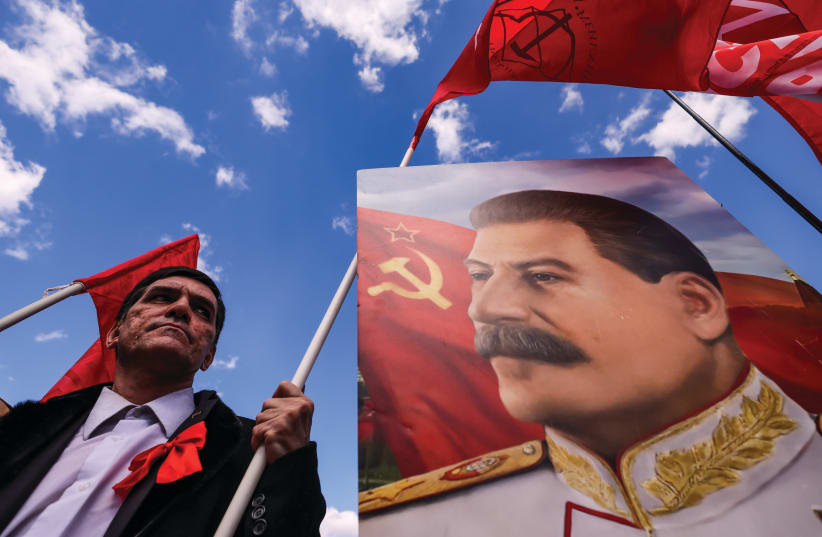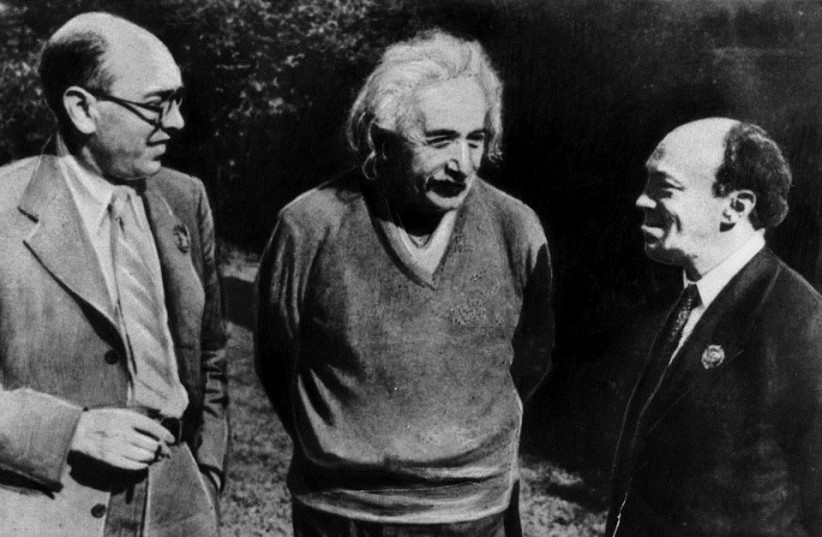“Haman then said to King Ahasuerus, ‘There is a certain people, scattered and dispersed among the other peoples in all the provinces of your realm, whose laws are different from those of any other people who do not obey the king’s laws, and it is not in your majesty’s interest to tolerate them.’” (Esther 3:8).
“Haman then said to King Ahasuerus, ‘There is a certain people, scattered and dispersed among the other peoples in all the provinces of your realm, whose laws are different from those of any other people who do not obey the king’s laws, and it is not in your majesty’s interest to tolerate them.’”
Book of Esther 3:8
On January 11, 1935, Moscow’s Bolshoi Theater hosted a celebration of the 15th anniversary of the Soviet film industry. On the program were Solomon Mikhoels and Veniamin Zuskin. Mikhoels, an outstanding actor and director, headed the Moscow State Jewish Theater; Zuskin, a fine comic actor, had made his reputation working with Mikhoels.
Mikhoels and Zuskin were applauded by the standing-room crowd upon their entrance onto the stage. As they performed a mime, the audience roared with laughter. After exiting and then returning to bow, they were hailed by a man in the state box, of medium height with a mustache. His name was Joseph Stalin.
The crowd, following professional etiquette, would usually not stand for fellow performers and was not sure how to react to the dictator’s gesture. Considering that Stalin had only six weeks before engineered the assassination of rival Sergei Kirov – and pinned the murder on any veterans of the Revolution whom he perceived as a threat – the actors and directors in the audience knew they had to acknowledge their leader.
Many – despite the mass arrests and middle-of-the-night disappearances of family, friends and neighbors – loved, or feared – Stalin. For a few moments, confusion filled the Bolshoi.
Mikhoels and Zuskin came to the rescue. They walked toward Stalin’s state box and applauded him wildly. The whole audience stood and thunderous applause rang out. Stalin was paid his homage.
Thirteen years and two days later, Mikhoels’s clothed corpse was discovered in a deserted lot in Minsk, sticking out of the snow, his identification intact. Soviet authorities announced that Mikhoels had been run over by a car. But Stalin’s own daughter overheard her father okay the execution over the telephone. KGB agents had actually beaten Mikhoels to death.
Zuskin took over Mikhoels’s post as administrator of the Jewish theater company. But it did not last for long. He was put on trial with 15 Jewish writers, journalists and academics.
On August 12, 1952, Zuskin and most of the rest – none of whom in any way believed Soviet Jews should emigrate to the fledging State of Israel – were executed for helping to engineer a Zionist plot to overthrow the USSR leadership. Only six years earlier, Zuskin and director Mikhoels had been awarded the Stalin Prize for Freilekhs, a smash-hit musical in Moscow.
Arkady Vaksberg’s 1994 work, Stalin Against the Jews, details the struggle of Mikhoels not to transform himself into one of Stalin’s Jewish marionettes, of which the dictator had many. Vaksberg was a Soviet and Russian lawyer, an investigative journalist, and a filmmaker who died in 2011. His book is a pioneering work based on archives that were opened shortly after the Soviet Union collapsed.
The author does not flinch in recalling the names and deeds of Stalin’s Jewish henchmen, from powerful Politburo member Lazar Kaganovich to the Cheka, NKVD and KGB men who shot other Jews in the back of the head, in the cells of the Lubyanka Prison. Almost all the executed were loyal Communists.
Vaksberg treats with understanding prominent Jewish Soviet writers – such as Ilya Ehrenburg – who to a greater or lesser degree compromised themselves through either indifference or devotion to Stalin or the Soviet system. Even poet Peretz Markish, a martyr with Zuskin in 1952, publicly praised the purges of the Great Terror.
Mikhoels, and other Jewish artists and community leaders, were not Sharanskys, Beguns, Nudels or Mendeleviches. But these later refuseniks would not have lasted long in Stalin’s empire. Even if what happened in the interior of Russia was neither the Ponary massacre in Lithuania of 100,000 people, nor Auschwitz-Birkenau, Stalin’s destruction of Jewish culture and religion – and the Jews’ identity as a unique people in the Soviet Union – must never be forgotten.
Stalin never considered the Jews to be "people" at all
VAKSBERG PRESENTS clear evidence that “the man of steel” never believed that the Jews were to be considered a people at all. Forty years before Pravda and Radio Moscow announced that a plot had been hatched by doctors (most of whom were Jewish) to assassinate the dictator and other top Soviet leaders – Stalin’s timely death aborted what might have become the pretext to destroy Soviet Jewry – Stalin had made clear his views on the Jewish future in a Communist state.
In 1913, Stalin published an essay in which he argued that “autonomy is being proposed for a nation whose future is denied and whose existence is still to be proved!” This essay attracted Lenin’s attention: Stalin became the first commissar of nationalities of the Soviet Union.
Born Josef Dzhugashvilli in Georgia, Stalin became a champion of Russian culture – filtered through the lens of Bolshevism, of course – at the expense of all ethnic expression.
Stalin’s views on Jewish nationality would come back to haunt those who wanted to preserve their culture (based in Yiddish language and the anti-Zionist, Socialist Bund) and their ethnic identity, if not always their religion. This clash ultimately resulted in the formation of the Jewish Anti-Fascist Committee.
The committee – originally the idea of the heads of the Polish Bund whom Stalin had imprisoned and executed after they fled the Nazis – provided the dictator with the perfect instrument to raise sympathy and cash in the West for the Soviet war effort. Mikhoels was its chairman; on its roster were the most prominent Jews in the Soviet Union. In 1943, Mikhoels and poet Itzik Fefer made a successful public relations and fundraising tour of England and North America on behalf of the committee.
At the war’s end, the Jewish Anti-Fascist Committee served no purpose for Stalin, who now only saw it as a hotbed of Zionist conspiracy. Lenin, quoting Marxist political writer Georgei Plekhanov, had himself said the Bundists were “Zionists afraid of seasickness.”
But for Mikhoels and the others, the committee could serve a valuable purpose for a Soviet Jewry scarred by the Holocaust, with many Jews without homes and facing open antisemitic discrimination. Mikhoels became the spokesman for these refugees.
With the failure of Jewish settlement in Birobidzhan, Mikhoels and other committee members believed the Crimea could serve as a Soviet republic for the Jews, where refugees could be resettled. Stalin, an opponent of Jewish nationality from the start, destroyed rivals Leon Trotsky and Lev Kamenev – respectively born with the family names Bronshtein and Rosenfeld – because Lenin would likely have chosen them as successors. Stalin’s own daughter, to his outrage, fell in love with a Jew.
Now Mikhoels was trying to wrest control of the committee – and Jewish destiny – from Stalin. Like Kirov, Mikhoels was too beloved among the people to be arrested and tried publicly. After engineering their assassinations, Stalin could eulogize both men in good conscience.
Mikhoels’s murder presaged the martyrdom of Zuskin, Markish and others of the cultural elite. It also was the beginning of the end of Jewish life and culture in the Soviet Union. Had Stalin lived longer, he might have well sent Jews into internal exile.
To Vaksberg’s credit, he is able to find the heroism of Mikhoels in a history filled with Jewish scoundrels, fear, ambivalence, blood – and bullets in the head. In 1935, when Mikhoels and Zuskin were wildly applauding the great dictator in the Bolshoi, the Moscow Jewish State Theater had featured King Lear. Mikhoels played Lear, Zuskin his fool.
The writer is a rabbi, essayist and lecturer in West Palm Beach, Florida.

